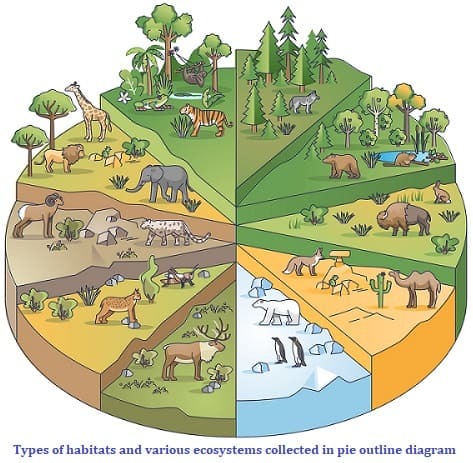

Ecological anthropology is the study of how people interact with the environment in which they live. It is a subset or branch of anthropology. The field focuses on the interactions and adaptations between people and the environment throughout generations. A collection of ideas and precepts known as general ecology are used to describe how animal and plant populations and communities adapt to and evolve in response to their environments. These ideas and precepts apply to several other areas, including energy flow, feeding relationships, resource acquisition, behaviour, etc.
 Plants and animals come in a variety of shapes and sizes that may be classified depending on their structure and behaviour. All living things rely on and are influenced by other living beings and non-living factors in their environment. The interactions among members of an ecological community involve the constant movement of energy and resources. Inside larger networks, there are networks of interrelated species. Human ecology is the scientific study of human populations and communities using ecological ideas, principles, theory, and research methodologies. The environment can affect three levels of biological organization—individual, population, and community.
Plants and animals come in a variety of shapes and sizes that may be classified depending on their structure and behaviour. All living things rely on and are influenced by other living beings and non-living factors in their environment. The interactions among members of an ecological community involve the constant movement of energy and resources. Inside larger networks, there are networks of interrelated species. Human ecology is the scientific study of human populations and communities using ecological ideas, principles, theory, and research methodologies. The environment can affect three levels of biological organization—individual, population, and community.
The fundamental techniques involve observing and documenting the status of society and nature, which naturally recognises the interactions between living things and their surroundings. Monitoring in anthropology involves observing how each person reacts to similar environmental factors and population-level variations. Since there are so many environmental factors that affect humans, monitoring the state of the environment is incredibly difficult. The physical variables include the weather, diet, pollution, etc.

According to twin studies, genetic makeup influences body form and physiological development more than all other environmental elements.
Population variations result from different genotypes or multifactorial recombination
for example, the form of the nose or the proportion of limb length to trunk length is unaffected by environmental changes. Europeans in tropical regions typically weigh less than those in frigid climates.
Human populations live in a variety of settings, from the tropical deserts of North Africa to the frigid wastelands of the Arctic. The human species can adapt to a wide range of environmental factors without going through significant microevolutionary changes. Human adaptability may be divided into two separate processes: adaptation and adjustment.
It entails alterations to the organism's physiology, structure, behaviour, or culture to enhance its ability to operate under stressful environmental conditions. Culture is a multifaceted concept that includes social institutions, religious beliefs, technological innovation, and the distinctive fusion of our biological and behavioural evolutionary background. It combines modern technology, such as computers, as well as subsistence lifestyles, such as global agribusiness and hunting and gathering. Culture is an acquired skill that is transmitted from one generation to the next. It alters how individuals view the outside world, making one culture different from another. However, it is crucial to stress that culture is not genetically fixed and that biological variables have an impact on people's propensity to integrate culture and function within it.
People acclimatise to hot, dry environments after a few weeks of exposure. Sweating is produced as the sweat glands become responsive. Additionally, perspiration includes salts, and sweating causes significant sodium loss. The salt content of perspiration decreases over time. The body conserves water by reducing the amount of urine as well. People in desert areas typically engage in less physical activity during the hotter hours of the day, which lowers body heat output.
A person may get high-altitude or mountain sickness when on vacation in the mountains. Breathing difficulties, mental and physical weariness, a quick heartbeat, disturbed sleep, and headaches that get worse with exertion are some of the symptoms. The body shows a response with a rise in breathing rate, which may double compared to sea level. A rise in blood capillaries and higher levels of haemoglobin, with an increase in red blood cells, improves their ability to transport oxygen.
Human physiological reactions to cold combine elements that improve heat generation and heat retention. As a result, the rate of heat loss is decreased when the temperature difference between the skin's surface and the surroundings is less. The body's subcutaneous fat layer acts as an insulator layer. The organism responds by speeding up heat generation when vasoregulatory systems are insufficient to stop heat loss. The thermogenesis of muscle is accelerated by shivering, and the temperature of the muscle increases to almost that of the core.
Since humans have always been studied in connection to their environments, ecological research is crucial. Ecological ideas and precepts help us comprehend people more fully. The systematic study of ecology employs a variety of approaches and procedures. To thrive in these ecosystems, humans have made adjustments to them. Increased physiological and physical adaptation has increased tolerance for harsh colds and heat. Behaviour changes are coordinated with the cultural traits of a certain group or population. However, it is also possible that both genetic and non-genetic factors contribute to climate change.
Q1. What is the work of an environmental anthropologist?
Ans. Environmental anthropology studies how people interact with their surroundings. It looks at how humans affect the surroundings in which we live and how our interactions with the natural world influence culture and social structure.
Q2. Who was the creator of the concept of ecological anthropology?
Ans. Ecological anthropology initially emerged as a reaction to cultural ecology, a branch of anthropology founded by Julian Steward, in the 1960s.
Q3. Describe social ecology in anthropology.
Ans. The study of social ecology examines how people interact with and respond to their surroundings and how these interactions impact society and the ecosystem as a whole.